World leaders gathered in Paris this week to pledge to make 2024 the “pivotal year” for improving access to clean cooking.
At an International Energy Agency (IEA) summit attended on Tuesday by heads of state and ministers from 27 countries, a total of $2.2bn was pledged to boost uptake of clean cooking technologies.
The summit focused on improving access to clean cooking in sub-Saharan Africa, where nearly four out of five people still rely on open fires to prepare food.
Ensuring global access to clean cooking by 2030 could save 2.5 million people – mostly women and children – from premature deaths associated with breathing fire smoke, the IEA says. It could also save 1.5bn tonnes of CO2 equivalent (tCO2e), around the same as a year of global shipping and aviation emissions.
But while the case for achieving universal clean cooking is clear, questions remain over how finance should be leveraged and what kind of solutions should be pursued.
The conference featured speeches from a number of fossil-fuel executives, who argued that cookstoves using liquified petroleum gas (LPG) offer the quickest and “cleanest” solution for boosting cooking access.
This drew criticism from African commentators, who noted that fossil-fuel representatives actually outnumbered African women, who made up just 17% of the people at the summit.
The role that carbon offsets should play in helping to distribute clean cookstoves in Africa was also much touted by heads of state and industry representatives.
Academic research has found that the “carbon credits” issued by cookstove projects in the past have been “largely worthless”. But advocates told the conference that new guidelines could enable the development of “high integrity” credits for projects in Africa.
Carbon Brief attended the summit at the United Nations Educational, Scientific and Cultural Organization (UNESCO) headquarters in Paris and spoke to experts about what the new global pledge could mean for climate, energy, nature and gender goals.
How could clean cooking aid climate, nature and gender goals?
Around 2.3 billion people – close to a third of the global population – lack access to clean cooking facilities, relying instead on wood, kerosene or coal as their primary cooking fuel.
The number of people without access to clean cooking is declining in Asia and Latin America. But in sub-Saharan Africa, continued population growth means the number of people without clean cooking access is still increasing.
Household air pollution, mostly from the inhalation of cooking smoke, is linked to around 3.7 million premature deaths each year, the IEA says. In Africa, women and children, who spend the most time at home, account for 60% of early deaths related to smoke inhalation and indoor air pollution.
Ensuring global access to clean cooking by 2030 is a key component of goal seven of the Sustainable Development Goals.
According to IEA projections, meeting this target could save 2.5 million people – mostly women and children – from premature deaths associated with breathing fire smoke.
In sub-Saharan Africa, many women and children are burdened with collecting firewood for hours each day in order to prepare a meal. The IEA projects that universal access to clean cooking could save the average household nearly 1.5 hours a day, which would likely, in turn, increase female participation in schooling and employment.
In addition to this, the IEA estimates that universal access to clean cooking – achieved in the way their scenario suggests – could save a total of 1.5bntCO2e from a combination of reduced combustion emissions and avoided deforestation for firewood.
At the summit in Paris on 14 May, heads of state and high-level private-industry figures repeatedly emphasised the clear benefits of improving clean cooking access in Africa – with many admitting they had neglected the issue for too long.
In his opening remarks to the summit, Akinwumi Adesina, a former Nigerian agricultural minister who is now president of the African Development Bank Group, spoke candidly of his experiences growing up in a low-income neighbourhood without access to clean cooking.
“I don’t wear glasses just because I went to university,” he told the summit, explaining that, as a child, he spent years standing over fire smoke, which likely damaged his vision.
He told the story of a female friend that died in a kerosene accident after fetching the fuel for use in cooking. Her family could not afford to buy a gas stove.
“How can we let these things happen?” he asked the conference.
Many speakers emphasised that, compared to other parts of the energy sector, such as heavy industry, improving access to clean cooking is “solvable”, as the technology needed is already available at a relatively low cost.
The IEA estimates that $4bn will need to be leveraged annually until 2030 in order to achieve universal clean cooking access. By comparison, total clean energy technology investment will need to reach $4tn per year by 2030 to meet net-zero, IEA says.
The clean cooking summit itself raised $2.2bn for clean cooking, the IEA said. IEA executive director Dr Fatih Birol promised that his agency would track where each penny was spent and reveal the results in a year.
Despite the new financial pledges and renewed focus, some lamented the lack of inclusion of African women at the conference.
Writing for African Arguments, the Ugandan climate activist Vanessa Nakate noted that the number of fossil-fuel executives outnumbered African women, who made up just 17% of the people in attendance.
One male session chair even cracked a joke about the lack of women speaking at the summit, telling the audience that the IEA should be pleased that clean cooking will no longer be viewed as “just a women’s issue”.
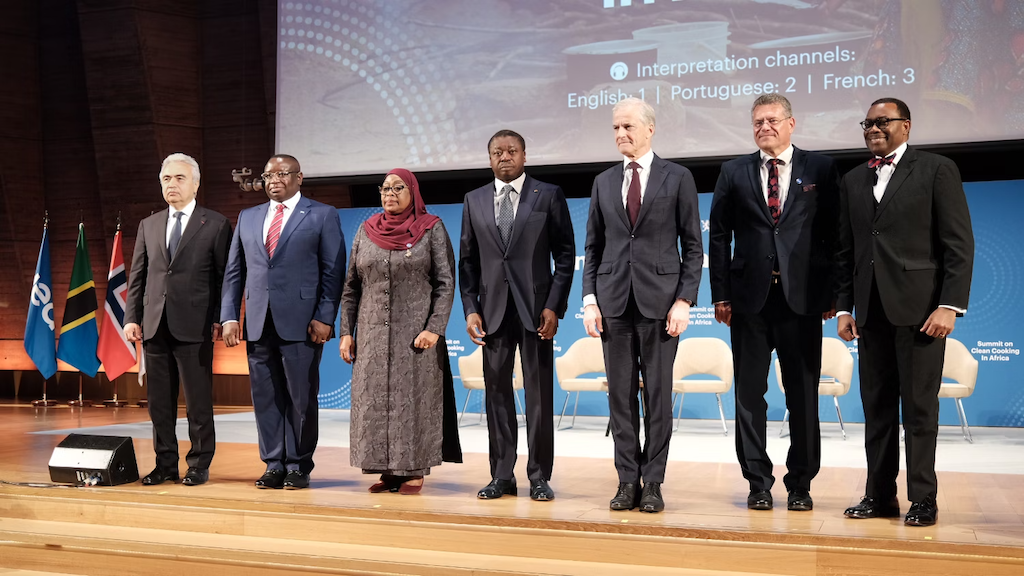
Later on at the summit, Graça Machel, a former Tanzanian education minister and deputy chair of the Elders, a group of global leaders started by former South African president Nelson Mandela, appealed for African women to be directly involved in high-level decision making on clean cooking. She told the conference:
“We need to build the capacity of women themselves so they aren’t just recipients. African women – we want to be investors, entrepreneurs, managers and customers. Any policy has to have the face of women, taking into account the magnitude [of our presence]. In our countries, we are millions. Clean cooking is about African women.”
Back to top
What are the solutions on offer for clean cooking in Africa?
More than 238 million people in sub-Saharan Africa live in informal housing, making the distribution of clean cooking technologies challenging.
Traditional “unclean” cooking involves a pot perched on top of a simple fire burning wood or waste products, or a kerosene dispenser.
According to the IEA, the main options for clean cooking include:
- Improved biomass stoves: An enclosed stove that burns solid fuel, but keeps heat from escaping and improves combustion, thereby reducing polluting smoke.
- E-cooking or electric stoves: Primarily hot plates, induction stovetops, rice cookers or electric pressure cookers that are plugged into an electricity source, which can come from renewable power.
- LPG stoves: A fossil-fuel burner that uses a mixture of propane and butane distributed in large pressurised cylinders.
- Biodigesters: A large vessel where organic matter (animal manure, agriculture residues or food waste) is decomposed into biogas. This biogas is then used in a burner-type stove.
- Ethanol: A simple burner that attaches to a small canister containing alcohol fuel made from crops, such as corn or sugar, that has been fermented and distilled.
- Gas stoves: A burner that uses fossil-fuel gas typically delivered to customers via distribution pipelines.
The IEA infographic below demonstrates how each of these methods work.
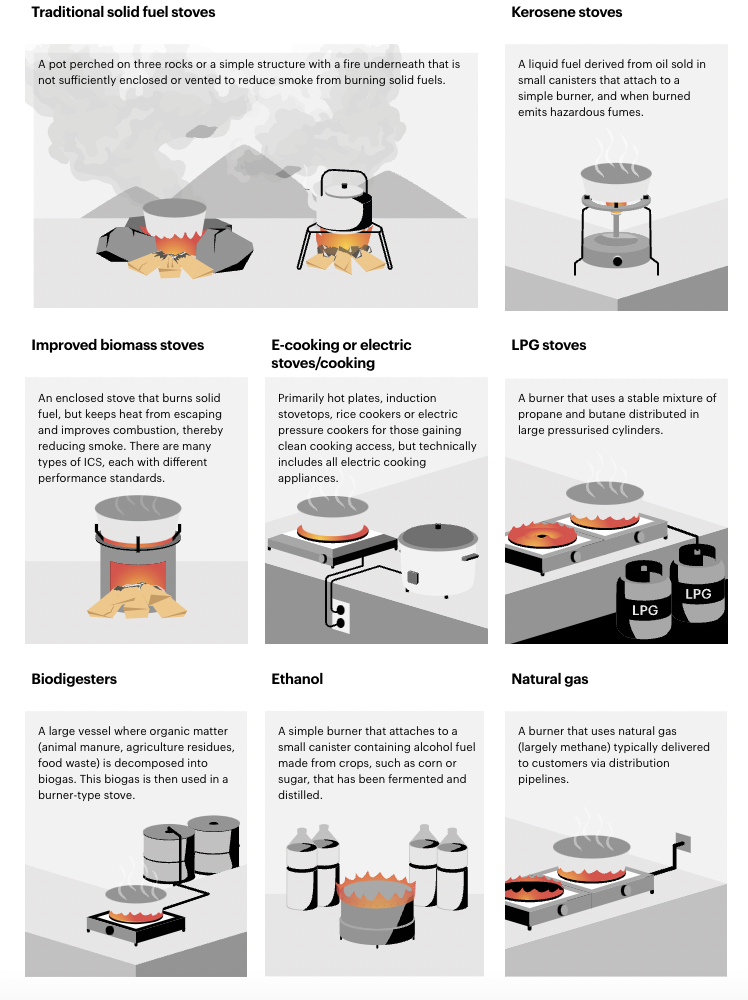
At the summit, fossil-fuel executives from companies such as TotalEnergies, Shell, Eni, Indian Oil and Equinor were keen to stress the role that LPG cookstoves should play in providing clean cooking access in Africa.
Patrick Pouyanné, chairman of the board and chief executive officer at TotalEnergies – one of the fossil fuel companies behind the controversial East African oil pipeline project – told the summit that his company will invest more than $400m in the development of LPG for cooking by 2030.
Eirik Wærness, senior vice president and chief economist at Equinor – a key funder of the controversial Rosebank oil field in UK waters – boasted that his company already supplies 10% of India’s LPG. He told the conference:
“We should not let the best – which is renewable energy – stand in the way of the good [LPG]. We will do all that we can to provide LPG – and also LNG [liquified natural gas] – as a viable, clean fuel.”
The IEA’s scenario for achieving universal clean cooking access sees a key role of LPG cookstoves. It notes that, in the last decade, 70% of people who gained “clean” cooking access globally did so through LPG.
In its scenario, LPG remains the “primary solution to deliver clean cooking access”, representing nearly half of new household access in 2030.
Below, an IEA graphic breaks down the numbers of households gaining access to different types of clean cooking in 2022 (left) and how its scenario expects households to gain access from 2023-2030.
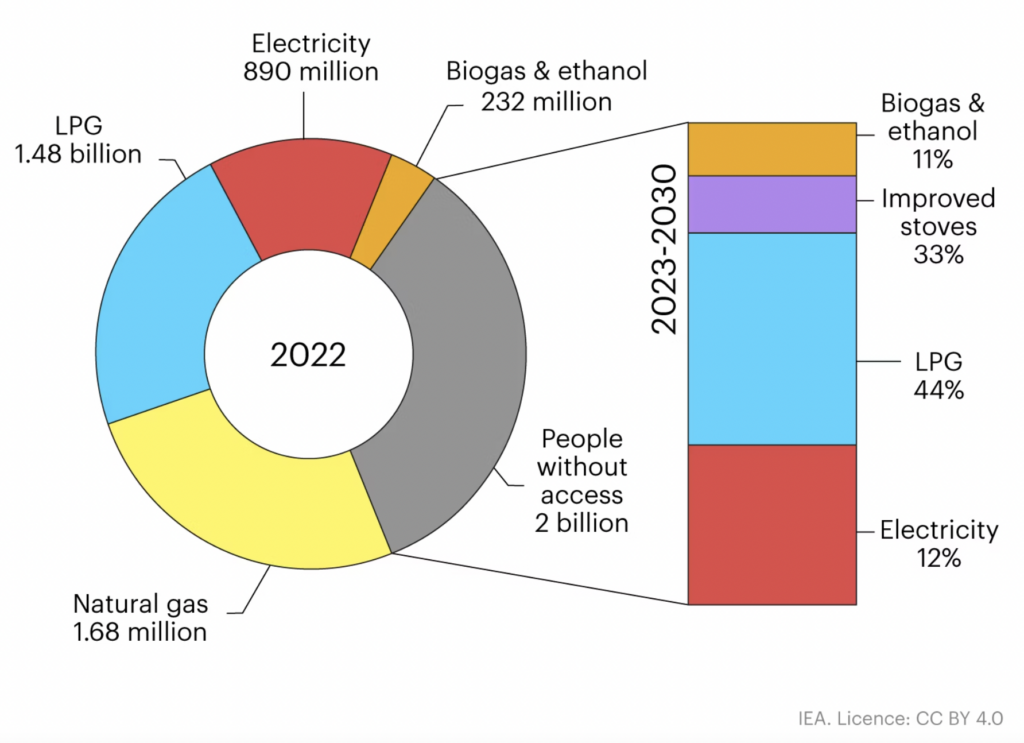
At the sidelines of the summit, Carbon Brief spoke to Dr Donnee Alexander, chief science officer for the Clean Cooking Alliance, a UN-backed NGO which helped to coordinate the summit.
Asked about whether a focus on LPG cookstoves over renewable-energy methods could risk locking African nations into further fossil-fuel dependency, she responded:
“I think Africa should be able to transition however they so desire. Because they have no energy. For me to say, ‘you need to transition in a certain way’, when a woman is cooking over an open fire and dying prematurely because she’s experiencing smoke inhalation every day of her life, who am I to say that she should not be transitioning to a much cleaner option compared to the baseline?”
But several African commentators reject the idea that fossil fuels are the key solution to Africa’s clean cooking crisis.
In her commentary on the summit, Nakate says:
“Natural gas is not clean…burning LPG or methane at home emits nitrogen dioxide, carbon monoxide and benzene, all [of] which can potentially trigger respiratory complications, including childhood asthma…Instead of trying to make gas affordable, the summit should seek to unlock investments that establish and scale ambitious and people-centred energy programmes. This is the most reasonable way to deliver decentralised energy to communities on the continent.”
Her thoughts are echoed by Mohamed Adow, founder and director of the Power Shift Africa thinktank in Kenya.
In a statement, he said there is “no evidence” that gas is the solution to providing clean cooking access in Africa, adding:
“What we need is a woman-centred approach that puts their needs first, not those of a greedy private sector looking to make profits. Rather than subsidies for private companies, that money would be better used investing in high efficiency, low-cost electric cookers for Africans.”
While most of the speakers at the summit focused on LPG, there was some recognition that renewable energy could be a way forward for providing clean cooking.
Stanlake Samkange, assistant executive director at the World Food Programme, said that his organisation had traditionally focused on supplying cleaner fuel stoves, but that “2024 is a departure”. He added:
“We are not just focusing on fuel efficient stoves but clean cooking…We are looking at electronic stoves and e-cooking. In Madagascar, we are looking to link that to solar panels.”
Back to top
How will improved access to clean cooking be financed?
The IEA estimates that $4bn will need to be leveraged annually until 2030 in order to achieve universal clean cooking access.
The clean cooking summit raised $2.2bn from public and private sources. This included new pledges from the EU, France, Denmark, the US, the UK and firms, including fossil-fuel companies.
It follows on from a high-level clean cooking event at the COP28 climate summit in Dubai, where the African Development Bank pledged to allocate a separate $2bn for clean cooking over the next decade.
At the Paris summit, Birol pledged that the IEA will closely monitor where the finance is spent and reveal the results in a year.
Throughout the conference, heads of state, ministers and company CEOs made it clear that they saw clean cookstove carbon-offset projects as key for leveraging finance and distributing new technologies in Africa.
Offsetting involves developed nations or companies paying for projects that distribute clean cookstoves, allowing them to then claim they have reduced their own emissions by paying to cut carbon in another country. (For a full breakdown, see Carbon Brief’s carbon offsets explainer.)
Stephanie Mbombo, presidential special envoy for the new climate economy for the Democratic Republic of the Congo, said that her president saw carbon offsets as the “key driver” for access to clean cooking, telling the summit:
“[With] carbon credits, we will save the world, but we will also save ourselves.”
The CEOs of clean cookstove carbon-offset companies were invited to speak alongside senior political figures and made bold claims about how they could play a pivotal role.
“With carbon credits, it’s solved, it’s done,” said Peter Scott, the CEO of the cookstove company BURN Manufacturing.
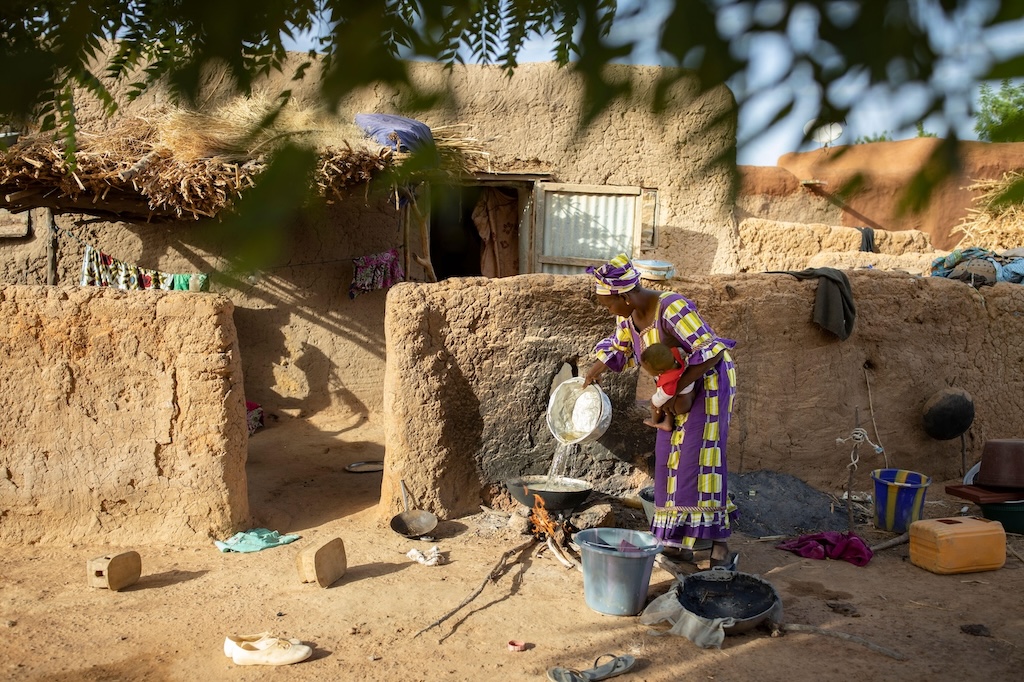
This sentiment was echoed in the declaration issued from the summit.
It said that participants “acknowledge the significant role that carbon credits and climate finance have already played in scaling clean cooking efforts, recognising the potential for further expansion of this support”.
But academic research has found that clean cookstove carbon-offset projects are “largely worthless” in emissions reductions terms.
A study in the journal Nature Sustainability found that nine in 10 of the 96m cookstove credits certified by leading carbon registries do not avoid the emissions they claim.
What is more, investigations by journalists, including at Climate Home News, have uncovered serious faults with clean cookstove projects, such as faulty stoves being distributed without communities being given access to repairs or replacements.
Gilles Dufrasne, policy lead at Carbon Market Watch, a watchdog of carbon offsets, told Carbon Brief that cookstove projects have “perhaps” been the least successful at achieving emissions reductions out of all types of carbon-offset projects. He added:
“This is a case of projects that very likely have significant positive impacts for sustainable development, and likely also positive climate impacts, but where the quantification of these impacts is extremely shaky. Most projects issue many more credits than they should, and that’s a problem if countries use it to meet their nationally determined contributions – as this [clean cooking summit declaration] suggests they could.”
Acknowledging the need for more “high integrity” cookstove credits, the conference saw the Clean Cooking Alliance launch new “principles for responsible carbon finance in clean cooking”.
Alexander told Carbon Brief the goal of the principles was to “address the challenges in the carbon market to ensure that we have both higher integrity but also higher demand”.
She said that the new principles could bring about tangible ways of improving the outcomes of cookstove carbon-offsets projects:
“We’re saying let’s measure reduction in fuel use [from distributing clean cookstoves], utilising standard methodologies. Or let’s have digital monitoring and verification so we know exactly when the stove is used. Things like that start to bring more integrity into the system.”
Dufrasne added to Carbon Brief that, with current projects offering little guarantee that promised emissions reductions will be achieved, there is a risk that the sale of more carbon credits to developed nations will lead to these countries reducing their emissions by less than if they had invested in alternative climate measures:
“Getting countries and companies to pledge finance to a fund, which then finances cookstove projects – with or without credits – is likely to be a better way.”
Back to top
Sharelines from this story











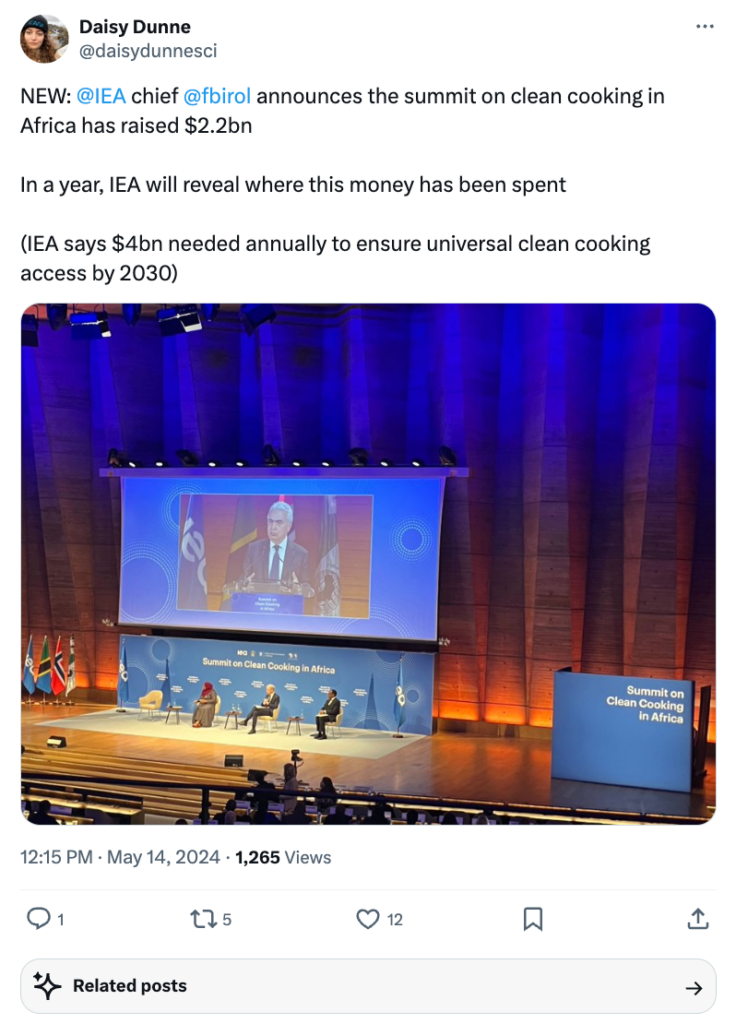







Discussion about this post